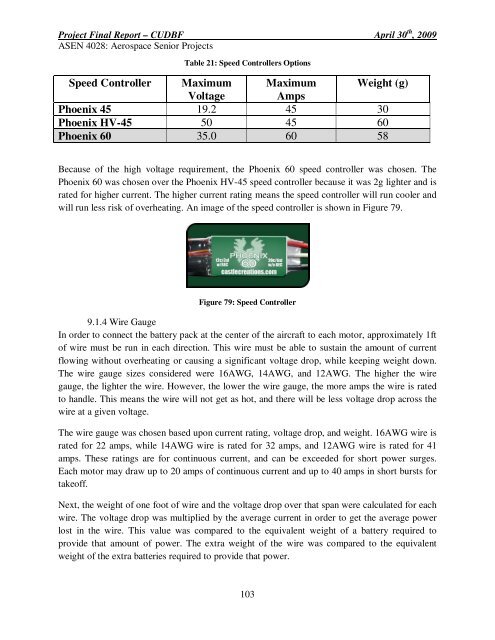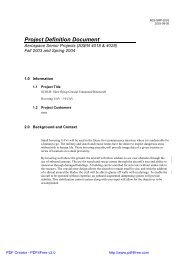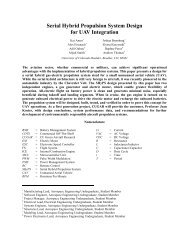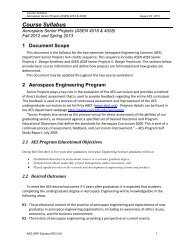PFR - Aerospace Engineering Sciences Senior Design Projects ...
PFR - Aerospace Engineering Sciences Senior Design Projects ...
PFR - Aerospace Engineering Sciences Senior Design Projects ...
Create successful ePaper yourself
Turn your PDF publications into a flip-book with our unique Google optimized e-Paper software.
Project Final Report – CUDBF April 30 th , 2009<br />
ASEN 4028: <strong>Aerospace</strong> <strong>Senior</strong> <strong>Projects</strong><br />
Table 21: Speed Controllers Options<br />
Speed Controller Maximum Maximum Weight (g)<br />
Voltage Amps<br />
Phoenix 45 19.2 45 30<br />
Phoenix HV-45 50 45 60<br />
Phoenix 60 35.0 60 58<br />
Because of the high voltage requirement, the Phoenix 60 speed controller was chosen. The<br />
Phoenix 60 was chosen over the Phoenix HV-45 speed controller because it was 2g lighter and is<br />
rated for higher current. The higher current rating means the speed controller will run cooler and<br />
will run less risk of overheating. An image of the speed controller is shown in Figure 79.<br />
Figure 79: Speed Controller<br />
9.1.4 Wire Gauge<br />
In order to connect the battery pack at the center of the aircraft to each motor, approximately 1ft<br />
of wire must be run in each direction. This wire must be able to sustain the amount of current<br />
flowing without overheating or causing a significant voltage drop, while keeping weight down.<br />
The wire gauge sizes considered were 16AWG, 14AWG, and 12AWG. The higher the wire<br />
gauge, the lighter the wire. However, the lower the wire gauge, the more amps the wire is rated<br />
to handle. This means the wire will not get as hot, and there will be less voltage drop across the<br />
wire at a given voltage.<br />
The wire gauge was chosen based upon current rating, voltage drop, and weight. 16AWG wire is<br />
rated for 22 amps, while 14AWG wire is rated for 32 amps, and 12AWG wire is rated for 41<br />
amps. These ratings are for continuous current, and can be exceeded for short power surges.<br />
Each motor may draw up to 20 amps of continuous current and up to 40 amps in short bursts for<br />
takeoff.<br />
Next, the weight of one foot of wire and the voltage drop over that span were calculated for each<br />
wire. The voltage drop was multiplied by the average current in order to get the average power<br />
lost in the wire. This value was compared to the equivalent weight of a battery required to<br />
provide that amount of power. The extra weight of the wire was compared to the equivalent<br />
weight of the extra batteries required to provide that power.<br />
103
















